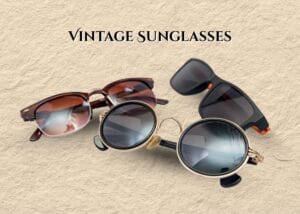Everybody knows that vintage sunglasses styles are making a comeback, but only a few know that it’s not just a style movement.
The thing is – vintage sunglasses from the 1930s through the 1990s are some of the hottest collectibles right now, with some selling for hundreds or even thousands of dollars! So, if you have an old pair that’s really vintage and rare, it could be worth big bucks!
But how will you know whether or not it is? This curated guide will help you spot the key signs of authentic sunglasses and factors that can make a pair hero or zero, along with some real examples that have sold for insane prices!
How to Know If Sunglasses Are Vintage? (Key Signs to Spot)
Vintage sunglasses from the 1930s to the 1990s generally outshine the modern pieces due to their high-quality materials, distinctive shapes, and ahead-of-the-time designs!
But how can you tell which pair is vintage and which one is just a copy? Scroll below to understand the key authenticity signs of vintage sunglasses!
The Materials
One of the key identification signs of vintage sunglasses is what they’re made of. Now, a pair generally has two parts: the frame and the lens. And the materials of both components tell you a lot about their age and background.
Frame Materials:
- Acetate Frames: Most quality vintage sunglasses used acetate, especially from the 1930s onward. You can spot real acetate pieces by their substantial build and smooth finish. But remember, early acetate pieces actually have a more brittle feel than today’s versions.
- Celluloid: This material was huge in the ’50s and ’60s, especially for cat-eye styles. You’ll often find it used for nose pads and decorative elements. But celluloid isn’t used anymore in glass manufacturing, so finding old glasses with it is like getting a real thing!
- Optyl: In 1968, a guy named Wilhelm Anger created Optyl, and it revolutionized the production of sunglasses. This thermosetting plastic was used by top brands like Carrera, Dior, and Paloma Picasso. Real Optyl frames need special heating (80-120 degrees) to adjust them – that’s one way to spot them.
- Real Tortoiseshell: Until 1973, some luxury brands used actual tortoiseshells for their frames. But then it got banned. So, if you find authentic tortoiseshell frames, you’re looking at a museum-quality piece.
- Metal Frames: Vintage metal frames often use superior alloys, like nickel silver and aluminum. Gold-plated and rolled gold were common in luxury pieces. Early Ray-Ban aviators, for instance, often featured such high-quality metal frames. American Optical pioneered military-grade metal alloys for its famous aviators.
Note: Most “tortoiseshell” patterns today are just acetate mimicking the look. Real tortoiseshell feels warm and has irregular, natural patterns with subtle color variations.
Lens Materials:
- Mineral Glass: Most sunglasses used mineral glass lenses until the late 1940s. These were heavier but gave incredible clarity. You can spot them by their sound – if you tap them gently, they make a distinct sound that’s different from plastic.
- CR-39 Plastic: CR-39 or “Columbia Resin #39” was revolutionary when it came out in 1940. These lenses are about half the weight of glass but give nearly the same optical quality. They also resist solvents, chemicals, and radiation better than other plastics.
Construction Quality
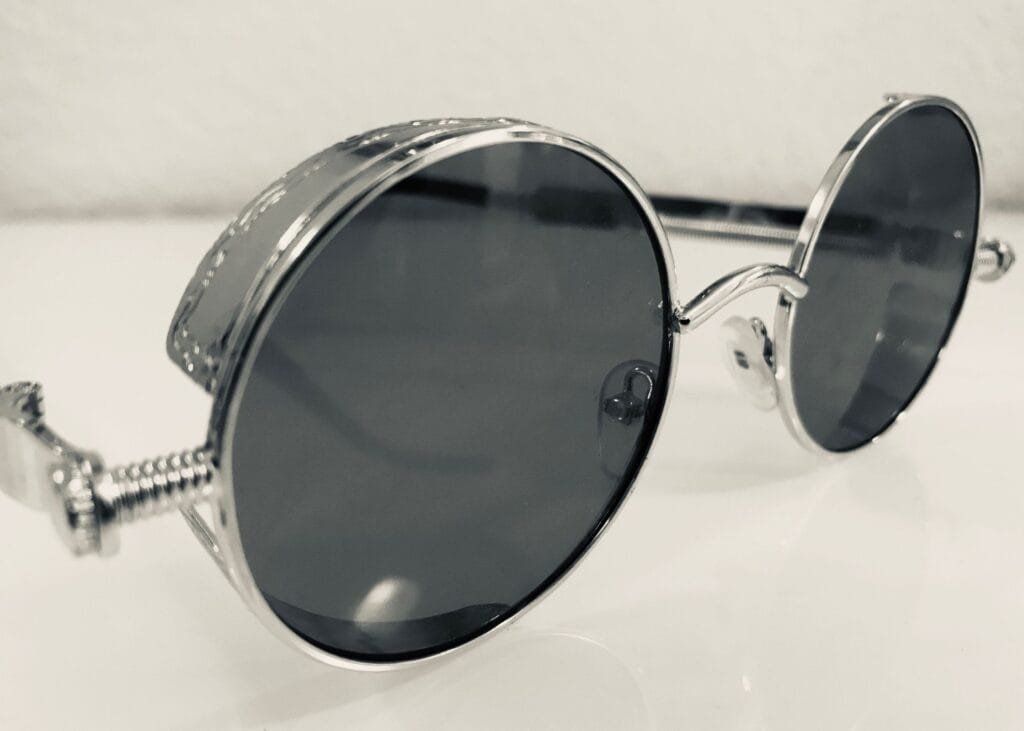
Apart from the frame and lenses, the hardware that connects and how it connects these elements are other important signs of age and authenticity.
- Hinges: Older sunglasses often have riveted hinges (small metal pins securing the hinge to the frame. You might also find barrel hinges with a specific number of barrels (like 5-barrel or 7-barrel hinges). Modern pieces have spring-loaded hinges!
- Screws: Vintage sunglasses usually used simpler flat-head screws, instead of Phillips-head or more complex screws common in modern eyewear. Also, these screws are generally made of higher-grade materials than modern mass-produced glasses.
- Nose Pads: Vintage nose pads in sunglasses were usually celluloid or high-quality rubber. Some examples have bridge and nose pads made from the same material as the frame or simple, hard plastic. Soft silicone nose pads hint at a modern piece.
Sunglass Designs & Styles
With the continuous transformation in style, sunglasses from each era had their signature looks. Knowing these styles will help you date and identify pieces easily. Here are some of the most collectible sunglasses styles you will come across:
Aviators
Bausch & Lomb patented this style on May 7, 1937, originally designed for pilots – thus the name! The original prototypes weighed only 150 grams and had specially formulated metal alloy frames with gold electroplating.
You can spot these by the teardrop shape and double bridge!
Cat-Eye Glasses
These sunglasses were the pinnacle of feminine style in the ’50s and early ’60s. The defining feature? The upswept curve that follows the brow line and lifts elegantly at the corners!
Legendary actresses like Marilyn Monroe and Audrey Hepburn made these glasses super famous; they’re still copied to date.
Wayfarers
These sunglasses broke all the traditional eyewear rules with their trapezoidal lenses that were wider at the top. Coming from Ray-Ban in the 1950s, these looked completely different from anything that came before.
Just to remind you, Bob Dylan wore and made this sunglass shape iconic! It’s still one of the most recognizable and collectible designs.
Teashades
Also called “John Lennon glasses,” these sunglasses featured a round wire-rim style. Original teashades sunglasses had perfectly round lenses with thin wire frames. You’ll often see celluloid nose pads on these.
Oversized “Jackie O” Frames
The First Lady Jacqueline Kennedy Onassis made oversized dark sunglasses her signature look in the 1960s and 1970s. You can spot these shades by their bulky, oversized frame in funky shapes.
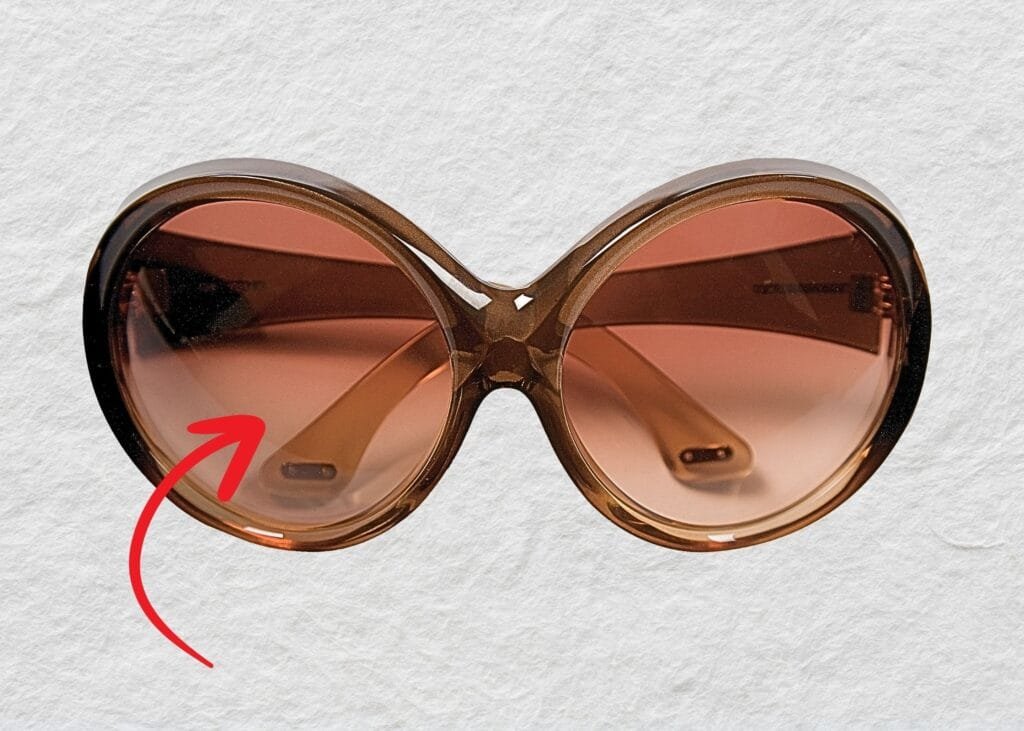
Brand Markings
Most authentic vintage sunglasses usually have certain markings that help you identify who made them, where, and when. Verifying these details is also crucial to assess the value of a pair.
You may find the following markings on vintage shades:
- Brand Logos: Logos or brand names generally appear on the temples, lenses, and sometimes the inner frame. The logo style can help date the sunglasses since brands often changed their logos over the years. For instance, vintage B&L Ray-Bans have “B&L” etched into the lenses.
- Model Numbers and Origin: You’ll usually find the model number, color code, and country of origin (like “Made in Italy”) inside the frame. You can cross-reference these markings with online databases to trace the style and model.
- Serial Numbers: Some vintage sunglasses have serial numbers that can help identify the exact model and production date. These are usually found on the forward part of the ear stems, closer to the lenses.
What Makes Vintage Sunglasses Valuable?
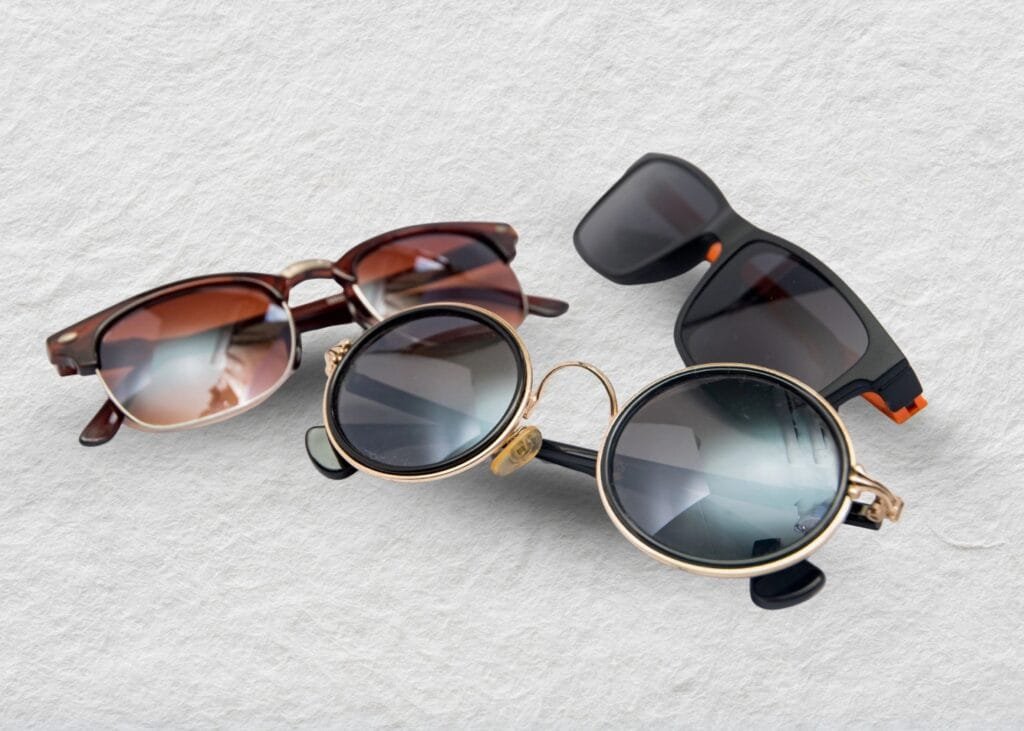
Now that you know how to identify a real vintage pair of sunglasses, you may think all pairs are worth a lot of money. But that’s not how it works. Several factors work together to determine what collectors may actually pay for a pair.
Here are all the things you need to consider to find out if your old sunglasses are worth anything:
Condition
Condition is the deal breaker – it can make or break the value of vintage sunglasses. Generally, the closer the sunglasses are to their original condition, the more they’re worth. To assess the condition, pay attention to these:
- Frame Condition: Vintage frames with original finishes, no cracks or stress marks, no warping, and properly functioning hinges are worth the most money! Any serious damage can cut the value significantly.
- Lens Condition: Old pairs must have clear, defect-free lenses for them to be valuable! Scratches, chips, or cloudiness can make even rare models nearly worthless. Also, lenses must be ORIGINAL; replacements are a big no!
- Hardware Integrity: The shades must have all the original screws, nose pads, and temple tips and in working condition. While replacement hardware might be necessary for wear, it can also hurt collector value.
Completeness
Having all the original accessories can double or triple the value of vintage sunglasses. Always look for the following accessories:
- Original Cases: Original packaging often has the logo, brand name, and specific details about the model. So, a pair with the original case is collectors’ gold! Period-correct cases, especially leather cases from premium brands, add serious value.
- Documentation: Look for original purchase receipts, warranty cards, or promotional materials. These not only help in authentication but also boost the value.
- Accessories: Additional things, like original cleaning cloths, lens pouches, or promotional items like pins, are a must-have! These small items can seriously add to an old pair’s value.
Rarity & Uniqueness
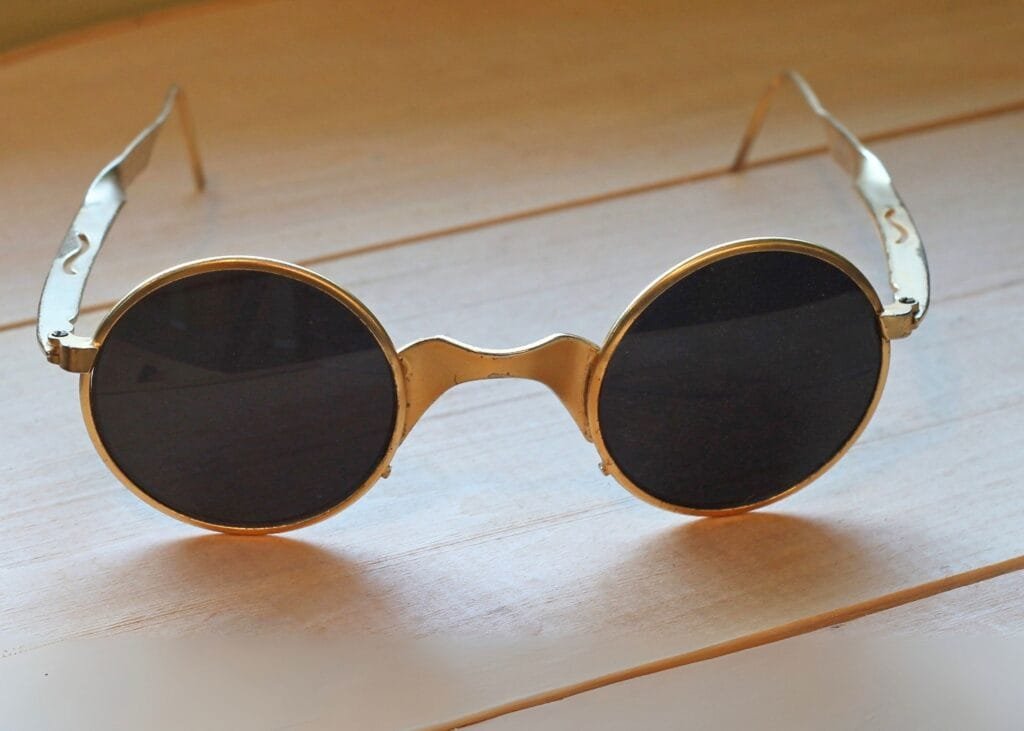
Rarity drives the value of any vintage item, and sunglasses are no exception. The rarer a model or pair, the more desirable and valuable it will be.
But what really makes a vintage pair rare? Check these:
- Discontinued Models: Sunglasses models that are no longer made, especially by companies that no longer exist, are rather rare and valuable.
- Limited Production: Some vintage models had short production runs due to several reasons. Early aviators, especially military models, are perfect examples of this. Experimental designs also fall into this category.
- Unusual Colors or Shapes: Sunglasses with extremely unique colors or shapes are considered rather rare! The 1960s saw wild color combinations and experimental shapes. These unusual pieces are often rare today!
- Brand Value: Vintage sunglasses from iconic brands will always be more valuable than those from less popular makers. Iconic brands like Ray-Ban, Persol, Cartier, and Jean Paul Gaultier command higher prices because of their innovation and style.
Provenance & Celebrity Associations
The history of who owned or wore the sunglasses can skyrocket their value and demand, especially if it’s a well-known celebrity.
For example, Tom Cruise’s Wayfarers in “Risky Business,” John Lennon’s Teashades, Jackie’s oversized frames, and Audrey Hepburn’s cat-eyes. All these styles are highly collectible today due to the iconic names associated with them!
That’s why it’s a must to trace the provenance of a vintage pair of sunglasses!
11 Cool Examples of Rare Vintage Sunglasses Worth Money!
Alright, here are some real examples of vintage sunglasses sold on e-commerce websites like eBay to show you how exactly the above factors work!
1. Oakley X-Metal Mars Leather Michael Jordan Glasses
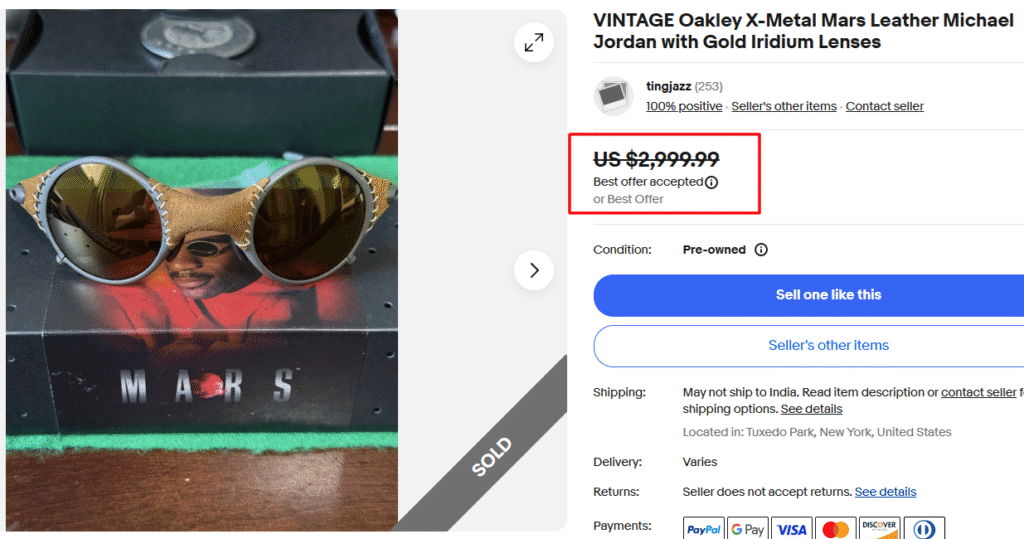
These ultra-rare sunglasses from Oakley were in production for only a little over a year in the late 1990s in relatively small quantities. While most shades feature celluloid or metal frames, these stand out with their unique X-metal and leather frames.
The leather accents and stitching often didn’t stand the test of time well, which is why finding this pair in good condition is so difficult today.
Original Mars models are one of Oakley’s most popular series, with values ranging from $1,000-$5,000, based on the condition and completeness. For instance, this pair came with the original box and sold for almost $3,000!
2. Matsuda 2809 90s Japan Terminator Sunglasses
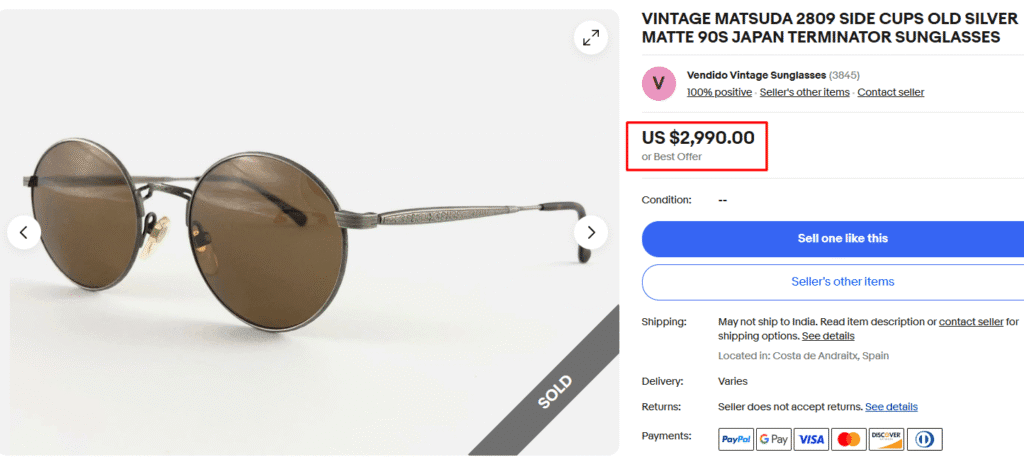
This example is the same model worn by Linda Hamilton as Sarah Connor in Terminator 2.
This ultra-rare piece from the cult brand Matsuda features spotless brown lenses and complex silver matte construction. What makes these unique are the removable side cups that give them a completely different look!
Matsuda released these in the 1990s, and they became a mega-hit! And while the brand continues to make these iconic sunglasses as limited heritage editions, original pieces from back in the day are super rare and collectible!
3. Rare Cartier Malmaison Trinity Wood Frame Sunglasses
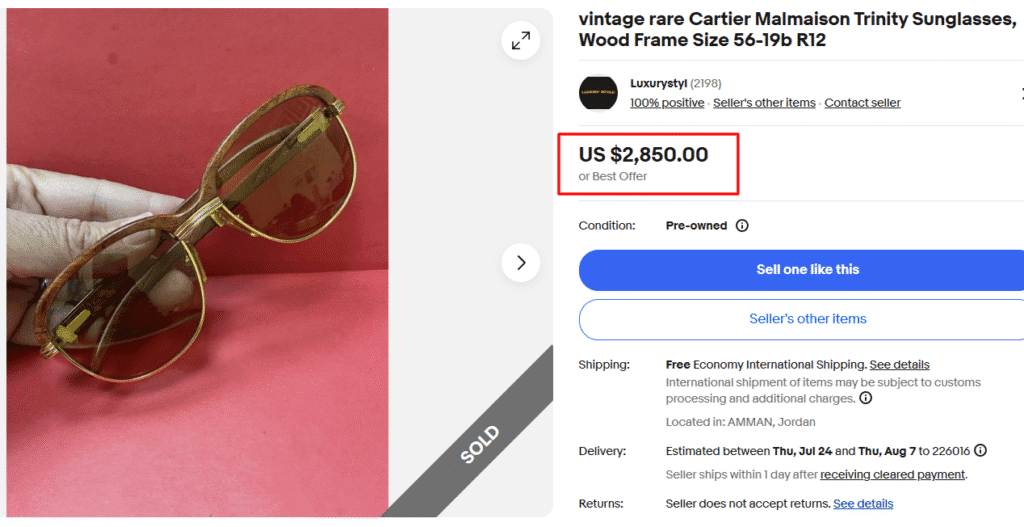
These rare Cartier vintage wood sunglasses from 1990 feature African Bubinga Wood construction with 22ct gold-plated accents and an original hard case. These models are popular as the “Malmaison.”
The unique combination of solid wood construction, gold plating, and Cartier’s signature luxury positioning makes these vintage sunglasses highly sought-after among collectors; no wonder this piece was bought for over $2,800!
4. Jean Paul Gaultier 56-0174 Blue-Yellow Sunglasses
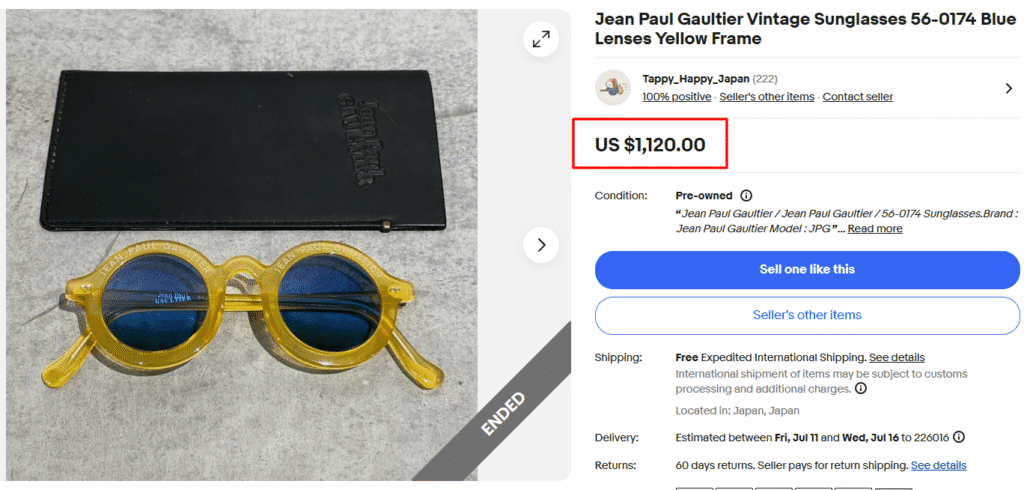
This funky vintage pair of sunglasses from 1991 is a glimpse of Jean Paul Gaultier’s avant-garde approach to eyewear design during the 1990s. It features a full early plastic round frame in yellow color with blue lenses, a bold color combination against the traditional ones!
You’ll see the brand name “Jean Paul Gaultier” right in the front of the frame, while the number “56-0174” appears on the inside of the stem. These funky sunglasses are collectible for their nerdy style and bold colors!
5. Persol Ratti Middle-East Exclusive Hassan 620 Sunglasses
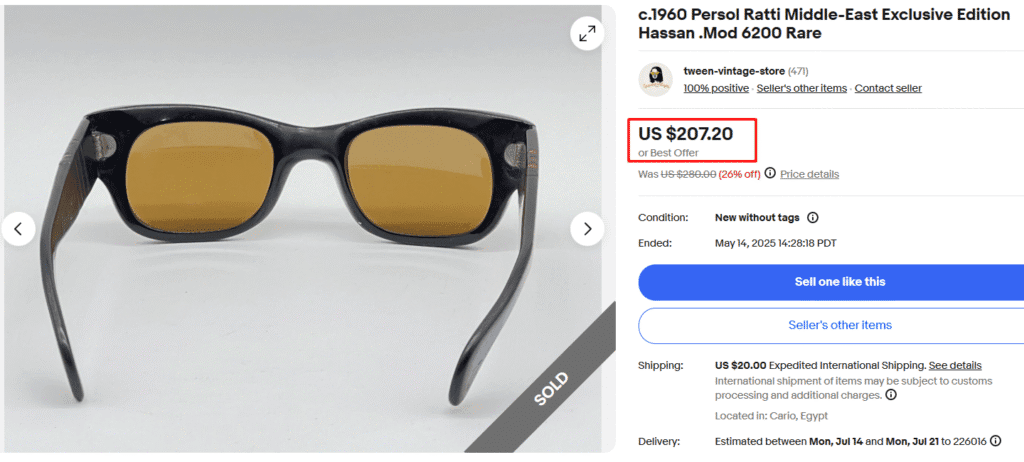
These ultra-massive vintage sunglasses by Persol Ratti are a handmade piece in Turin during the 1960s. It’s the iconic Middle-East exclusive edition produced in very limited quantities, making surviving pieces rare today.
You can spot the authentic version by the “Ratti” and “6200” markings on the inside of the stems. These shades are a true example of the superior Italian manufacturing that made Persol legendary.
6. Chanel S/S 2007 Round Half-tint Sunglasses
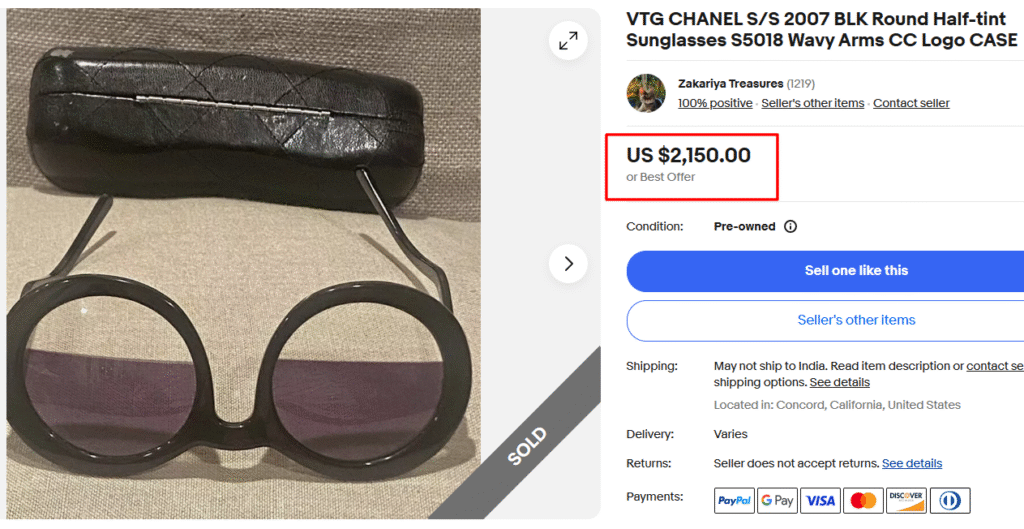
This is a rare pair of Chanel sunglasses from Karl Lagerfeld’s 2007 runway collection! It features a sturdy black plastic frame with signature half-tinted lenses and wavy temples sporting the iconic CC logo.
These are collectible runway archive sunglasses only produced for a brief period, making them incredibly rare and valuable today, as reflected by the steep price tag of $2,150!
7. B&L Ray-Ban G15 Crystal Wayfarers 5022 Sunglasses
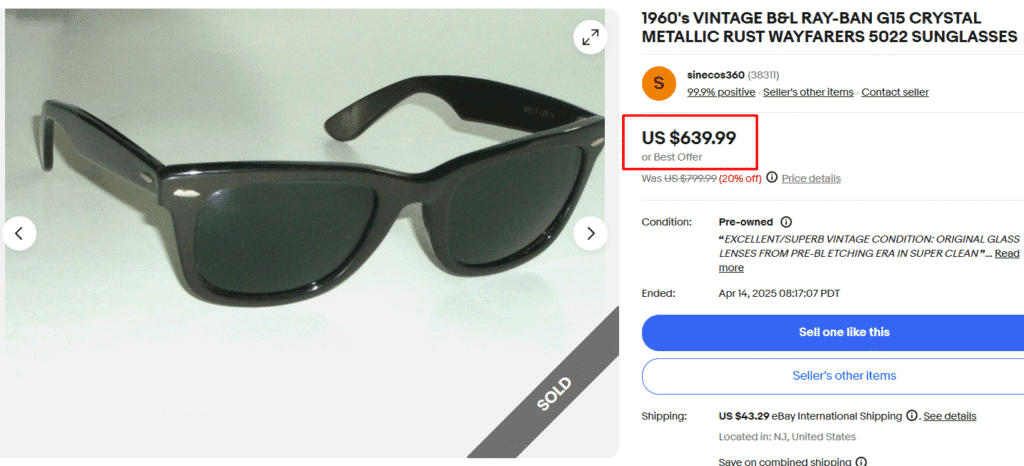
A true Wayfarer model, this is an authentic 1960s Bausch & Lomb production featuring the coveted G15 crystal lenses and rare metallic rust coloring. The 5022 model number indicates the standard-size globally iconic Wayfarer style.
Pre-1998 B&L sunglasses generally have superior mineral glass G-15 lenses with “BL” etchings. The metallic rust frame color was a limited production run, making surviving examples highly sought-after!
8. Oakley Over The Top FMJ Fire Lens Sunglasses
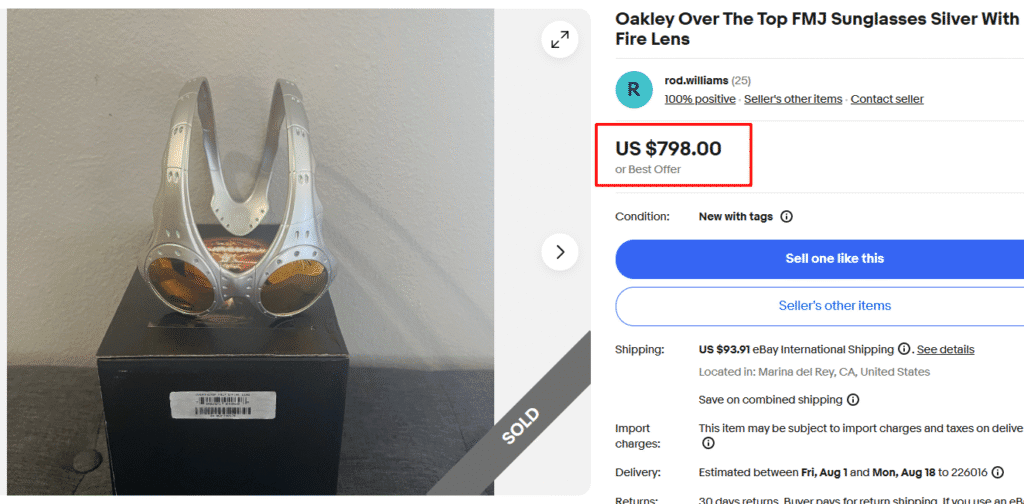
These ultra-rare Oakley pieces feature one of the most unique eyewear designs ever produced! You can identify these by their head-mounted design, Chrome appearance that results from the O‑Matter base frame plated with FMJ (Full Metal Jacket), and reflective Fire Iridium lenses.
This style gained fame at the 2000 Sydney Olympics when Trinidad & Tobago track team members competed wearing them. Since discontinuation in the late 1990s, finding these sunglasses in excellent condition is difficult, making them rare and valuable!
9. Bausch & Lomb Ray-Ban Aviator Pilot Sunglasses
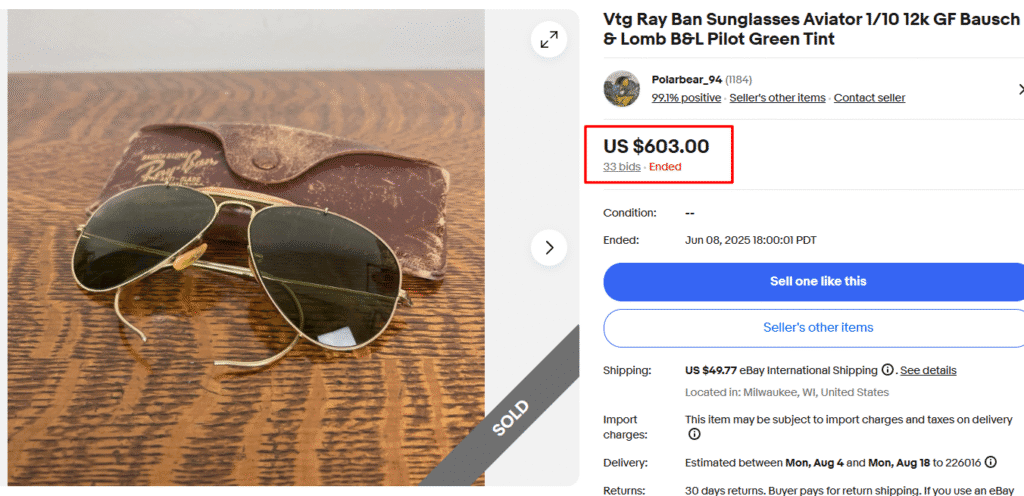
These early Bausch & Lomb sunglasses from the 1940s-1950s feature the rare 52mm G-15 lenses, smaller than the common 58mm aviators. These are a piece of Ray-Ban’s military heritage, originally designed for Army Air Corps pilots during WWII.
Look for the “1/10 12k GF” marking to verify the authentic shades. This marking means that 1/10 of the metal frame is made of 12k gold (mainly the outer gold plating). Surviving early Aviators in excellent condition are extremely rare after 50-70+ years!
10. Carrera Porsche Design 5621 Sunglasses
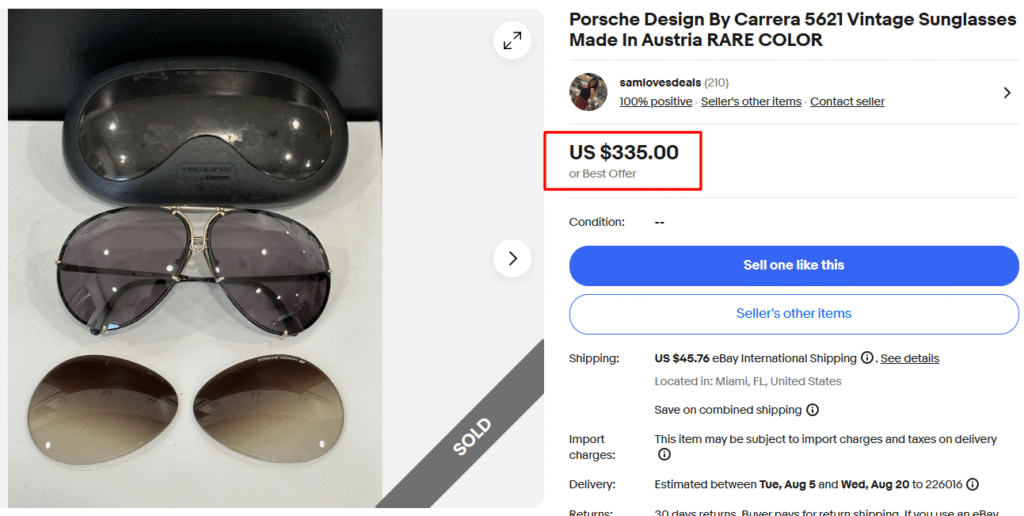
This iconic 1980s model resulted from the collaboration between Porsche and Carrera in 1979. The two companies together created one of the most wanted sunglasses designs, featuring interchangeable lenses, unique designs, and Optyl lenses.
You can spot this pair by its oversized aviator shape with a double-bridge frame. It also features a spring‑loaded hinge to easily swap lenses. This exact model was worn by David Hasselhoff in “Knight Rider” and by celebrities like the Kardashians, Victoria Beckham, and Paris Hilton, becoming highly desirable.
11. Balenciaga Oversized “Jackie O” Sunglasses
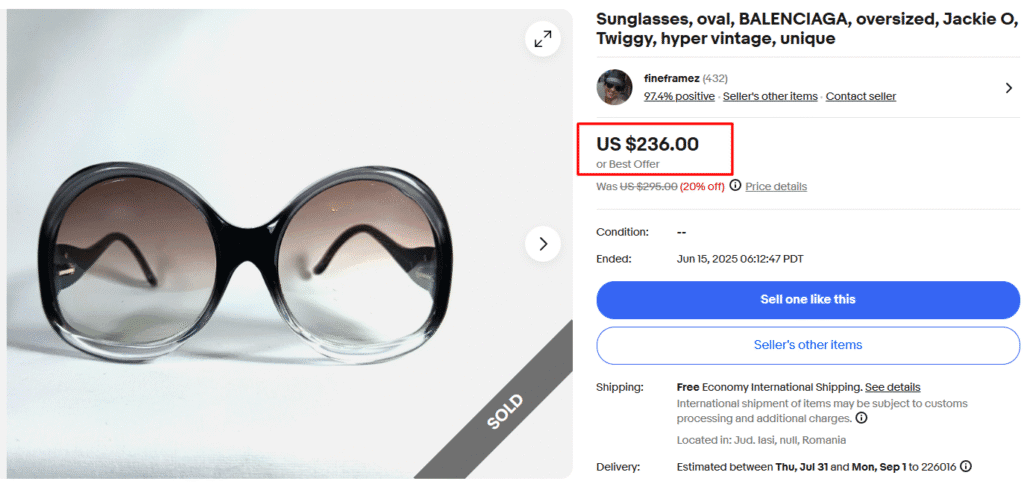
These vintage oversized Balenciaga sunglasses capture the iconic “Jackie O” and Twiggy aesthetic that became super popular in the 1960s. The revolutionary design with its oval shape and massive proportions marked the deviation from traditional eyewear styles.
Besides, the association of these sunglasses with style icons like Jackie Kennedy Onassis and supermodel Twiggy is what makes them highly collectible among women, especially female collectors!
Note: This article is intended for informational, educational, and entertainment purposes only. Some images are illustrative and may not represent actual brands, products, or related entities. All trademarks, product names, brand logos, packaging, and other intellectual property referenced remain the exclusive property of their respective owners. Any brand mentions or references are provided solely for descriptive and educational context and do not imply any formal or commercial association.

